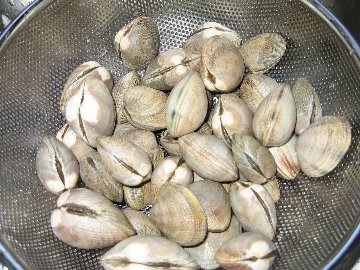A simple clam soup
This soup is simpler and lighter than chowder, a good kickoff for a hearty autumn dinner. On Thanksgiving day, post a steamy tureen of it outside your kitchen and let the guests help themselves to as much or little as they like from handy mugs or teacups. Our recipe is derived from several nineteenth century New England sources. Makes about a quart and may be doubled or otherwise increased.
 -1 Tablespoon unsalted butter
-1 Tablespoon unsalted butter
-1 Tablespoon flour (Wondra preferred)
-1 pint scalded heavy cream
-1 pint shucked clams, minced (see the notes)
-about 1 cup warm strained clam liquor (also see the notes)
-about ¼ teaspoon cayenne
-about ¼ teaspoon mace
-salt and pepper
-minced parsley (optional)
- Melt the butter in a heavy soup pot over medium heat and whisk the flour into the butter to form a uniform paste.
- Slowly stir the clam liquor into the cream mixture, bring it to a boil and immediately reduce the stock to a simmer.
- Add the clams, cayenne and mace, if you are using it, to the pot, then check the soup for salt and pepper.
- (Optional) You may puree the soup if you like.
Notes:
- You can buy shucked, chopped quahogs from good fishmongers in the United States, particularly in New England, and they are more than suitable for this soup. Clams from a jar or can can work too, but they are not quite as good.
- If you lack liquor from your clams, bottled clam juice is fine.
- Mrs. Lincoln’s recipe for ‘Puree of Clams’ from the 1901 edition of her Boston Cook Book (first published in Boston during 1884) with the superb subtitle What To Do and What Not To Do in Cooking is a little unclear. She essentially follows the britishfoodinamerica sequence, ending with the instruction to strain the soup into a tureen. (Lincoln 158) Does she mean to discard the clams? We are unsure but do not think so; we think she assumes that her reader will push the minced clams through a wire strainer. She does not add the mace.
- Some four decades earlier, however, Catharine Beecher does include mace in her clam soup:
- “Wash a peck of clams and boil them in a pint of water, till those on the top open and they come out easily. Strain the liquor, and add a quart of milk. When it just boils thicken with two and a half spoonfuls of flour, worked into three of butter, with pepper, mace and other spices of your taste. It is better without spice.” (Miss Beecher’s Domestic Receipt Book, New York 1846, 2001 Dover facsimile, 60) The use of mace, and of the term ‘receipt’ in the title, reflect the persistence of English practice in New England.
- Mrs. Lincoln also offers her reader “a method of preparing clam soup, if needed quickly: Heat the clam broth to a boiling point: add the clams cut fine: season, and pour into the tureen over two eggs beaten up with the boiling milk.” (Lincoln 154; emphasis original) She uses the meat from ½ peck, or four quarts of clams in their shells cooked until they open and then chopped; just use the same amounts of minced clams, cream and clam broth as in our recipe. Her seasonings are cayenne, salt and pepper.
- Fanny Merritt Farmer also puts eggs, whites in one and yolks in another, for two of her clam soups from the famed Boston Cooking-School Cook Book (Boston 1896).
- As Keith Stavely and Kathleen Fitzgerald explain in Northern Hospitality (Amherst 2011), their peerless study of New England cookbooks from the seventeenth through early twentieth centuries, the use of eggs to thicken soup is a prototypically English practice. The use of milk or cream at the time that these recipes appeared, however, was a Yankee contribution.
- Clams, a food synonymous with New England, were not always so esteemed. Early on they amounted to something analogous to the foraged ‘famine food’ of Irish folk memory, and eating them also was considered somewhat embarrassing if not disreputable due to their association with the foodways of ‘savage’ native Americans. Stavely and Fitzgerald point out that clams “did not make their print debut until the early nineteenth century, in American imprints of English cookbooks.” (Northern Hospitality 158)

